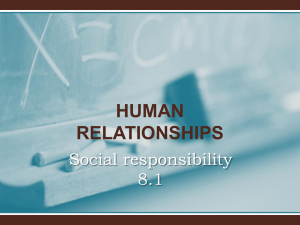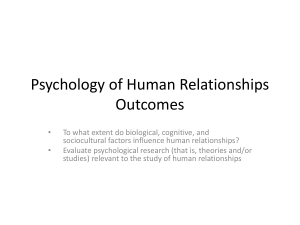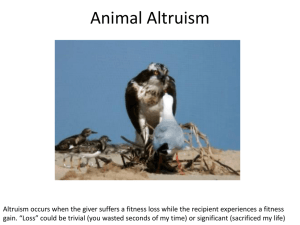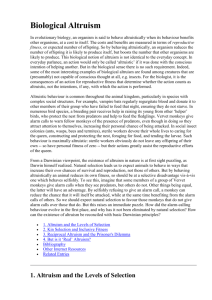Pro-social behaviour
advertisement
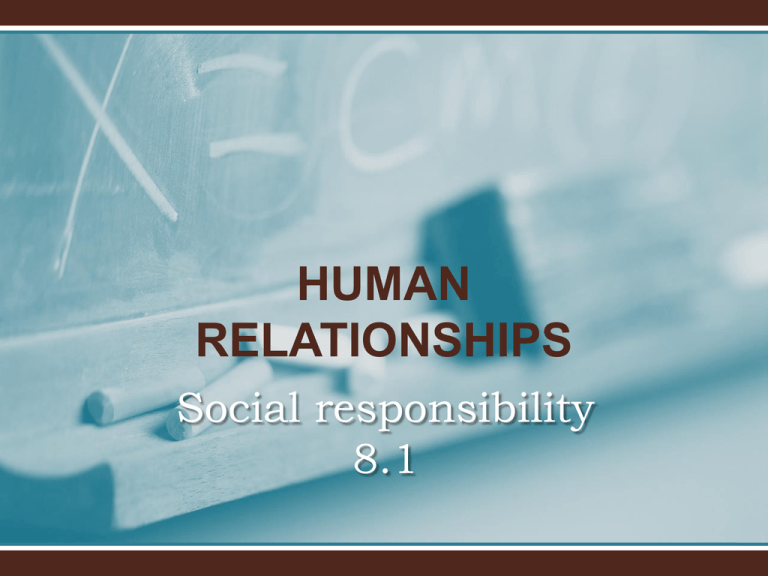
HUMAN RELATIONSHIPS Social responsibility 8.1 Social responsibility • Learning outcomes 1. Evaluate psychological research (through theories and studies) relevant to the study of human relationships 2. Distinguish between altruism and pro-social behaviour 3. Evaluate research investigating altruism 4. Explain cross-cultural differences in pro-social behaviour 5. Evaluate research investigating bystanderism Help or not to help… • Kitty Genovese: Http://www.youtube.com/watch?v=JozmWS6xYEw &feature=related • Another example from the USA http://www.youtube.com/watch?v=KIvGIwLcIuw And another…smoke filled room: http://www.youtube.com/watch?v=KE5YwN4NW5o terms • Pro-social behaviour – is when a behaviour that benefits another person or has positive consequences (focus on the outcome not the motivation) • Helping behavior – is when a behaviour intends to help or benefit another person (is planned) • Altruism – is when one helps another person for no reward, EVEN at some cost to oneself Activity: come up with one example for each Psychological research on altruism • Biological altruism (evolutionary) • Psychological altruism (mostly cognitive) Biological altruism Biological altruism – what could be advantageous to the group a person belongs to rather than the individual alone • Kin Selection theory: the closer/ more related the greater the chance of altruistic behaviour • Dawkins (1976) proposed the "selfish gene theory" explains why individuals are willing to sacrifice themselves to protect the lives of their kin but does not explain why one help strangers… and genes does not directly cause a behaviour (more complex than that) Reciprocal altrusim theory • By Trivers (1971) • ”you scratch my back and I’ll scratch yours” • Meaning that one help (even strangers) with the expectation that the favour will be returned in the future • Come up with an example • "prisoner's dilemma" – game by Axelrod and Hamilton Evaluation of the evolutionary theories • Animals • Culture • Adoption Psychological explanations of altruism Psychological explanations of altruism • Lerner and Lichtman (1968) carried out an experiment similar to Milgram’s • Schaller and Cialdini (1988) proposed the negativestate relief model – we help so we feel better (reduce the distress) or we walk away • The empathy- altruism model by Batson et al. (1981) consists of two emotions: personal distress (egoistic behavior) and empathetic concern (altruistic behaviour) • Is empathy biological or learned? Read the study on p. 262 and link it to the biological level of analysis Are you really caring ( CAS) • P. 261 • John Rabe: a good Nazi? P. 263 Pro-social behaviour and the bystander effect • Starting on p. 263 – 268 • Two responisible for p. 263 – 265: • Two responsible for 265- 267 :the arousal-costreward model of pro-social behaviour • One 267- 268: the role of social norms in prosocial behaviour Read and present to the others – clearly and without reading from the paper – use only key words – present Tuesday after the break. Cross-cultural research on pro-social behaviour Last part of 8.1 Culture play a role on pro-social behaviour • Whiting (1979) studyied children in six countries and their helping behaviour. Results were that Kenya, Mexico scored high compared to US that scored lowest • - why do you think? Social identity theory • Helps to explain how we determine wheter to help someone or not – we tend to help more to those who are similar to us • The US were most likely to help someone from an out-group compared to Chinese and Japanese who helped the most to their in-group Levine et al. 1990: helpfulness towards strangers was assessed • In 36 cities across the US • And 23 large cities around the world • Independent field experiments were used • Explain the experimental design + mention + and - Levine et al. 1990: helpfulness towards strangers was assessed • Results: • In the US: • Small and medium-sized cities in the south east were most helpful • North-eastern and west coast cities the least • Best predictor: population density Levine et al. 1990: helpfulness towards strangers was assessed • Results: using the US data to compare: • Latin America highest • Helping rates high in low economic productivity countries (less purchasing power for each citizen) • Higher in cities with slow pace of life ( walking speed) • Thought that the city’s personality affects individual behaviour (what do think Helsingborg’s is?) Levine et al. 1990: helpfulness towards strangers was assessed • However, two cities went against these tendencies. Copenhagen and Vienna, which are both fast paste and have more money • And in Kuala Lumpur (slow paste) they were not helpful at all • Conclusion: studies show that where the person was raised has less effect on helping than the place where they currently live Levine et al. 1990: helpfulness towards strangers was assessed • The methodological limitations: • 1-5 on p. 270 go through • Do “be an enquirer” on p. 270
